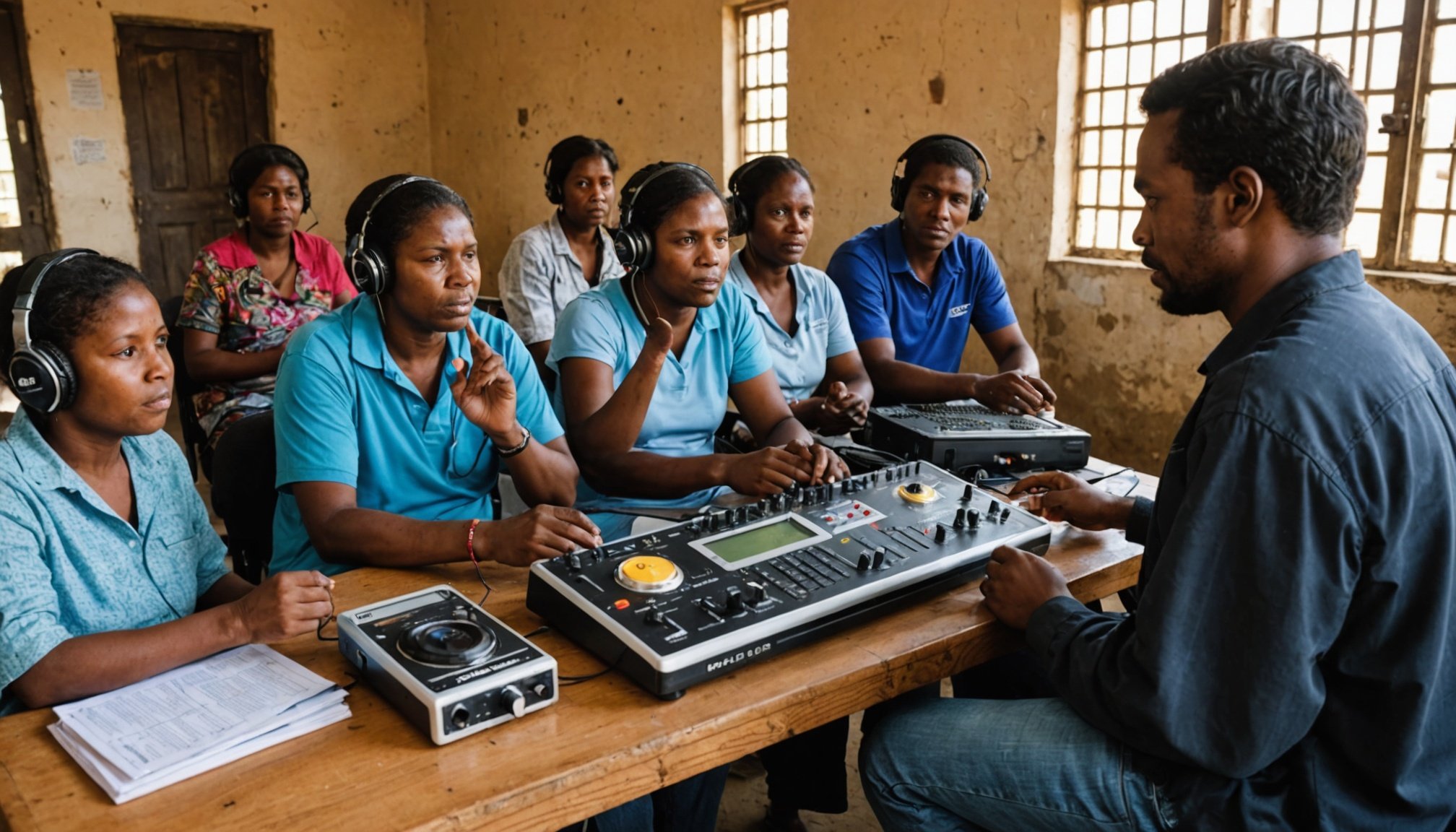Transforming Rural Health: How Community Radio Stations Educate and Empower Local Populations
In the heart of rural areas, where access to modern healthcare and information can be scarce, community radio stations have emerged as powerful tools for education, empowerment, and health transformation. This article delves into the significant role that community radio plays in enhancing rural health, highlighting its impact, strategies, and the stories of those who have benefited from these initiatives.
The Power of Community Radio in Rural Areas
Community radio stations are more than just a source of entertainment; they are vital hubs for information dissemination, public engagement, and community development. In rural areas, where traditional media often struggle to reach, community radio fills the gap by providing localized content that resonates with the local population.
Also to read : Enhancing post-operative healing: unlocking the benefits of visualization strategies
Reaching the Unreached
One of the primary strengths of community radio is its ability to reach remote and marginalized communities. For instance, in Africa, initiatives like those supported by the International Fund for Agricultural Development (IFAD) and organizations such as YenKasa Africa have used radio to address critical issues like sustainable seed systems and agricultural practices. These programmes are broadcast in local languages, ensuring that the information is accessible and understandable to the target audience[1].
Interactive and Engaging Content
Community radio stations are not just one-way communication channels; they are interactive platforms that encourage public engagement. Through live call-ins, mobile phone polling, and on-air dialogues, farmers and community members can voice their concerns and share their experiences. This interactive approach was highlighted in a project where African small-scale farmers used radio and mobile phones to send messages and propose solutions to their agricultural challenges[3].
In the same genre : Enhancing post-operative healing: unlocking the benefits of visualization strategies
Educating Through Radio Programmes
Education is a cornerstone of community radio’s role in transforming rural health. Here are some ways in which radio programmes contribute to this mission:
Health Awareness and Education
Radio programmes focused on health awareness are designed to educate listeners about various health issues, prevention strategies, and available healthcare services. For example, a radio programme in Ghana titled “Protecting Indigenous Seeds for Sustainable Seed Systems” not only discussed agricultural practices but also touched upon the broader health implications of food security and sustainable farming methods[1].
Addressing Specific Health Concerns
Community radio stations often address specific health concerns relevant to their local communities. This could include programmes on maternal health, child nutrition, or disease prevention. In Rwanda, for instance, community radio stations have been used to disseminate information on HIV/AIDS, malaria, and other prevalent health issues, helping to reduce stigma and increase awareness.
Empowering Local Communities
Empowerment is a key aspect of community radio’s impact on rural health. Here’s how it works:
Empowering Women and Young People
Community radio stations often have programmes specifically designed for women and young people, addressing their unique health needs and challenges. For example, radio programmes may focus on reproductive health, family planning, and gender equality. These initiatives help empower women and young people by providing them with the information and resources they need to make informed decisions about their health[4].
Building Community Engagement
Community radio fosters community engagement by involving local people in the production and dissemination of content. This not only ensures that the information is relevant but also builds a sense of ownership and responsibility among community members. At the World Farmers’ Organisation 2024 Annual Meeting, the role of community radio in engaging farmers and other stakeholders was highlighted as a crucial component of rural development[1].
Practical Insights and Actionable Advice
For those interested in leveraging community radio for rural health transformation, here are some practical insights and actionable advice:
Building Partnerships
- Collaborate with Local Organizations: Partnering with local health organizations, agricultural cooperatives, and community groups can enhance the reach and impact of your radio programmes.
- Engage Local Experts: Involve local health experts and community leaders in your programmes to ensure the information is accurate and relevant.
Using Technology Effectively
- Leverage Mobile Technology: Use mobile phone polling and other interactive technologies to engage listeners and gather feedback.
- Social Media Integration: Complement your radio programmes with social media campaigns to reach a broader audience.
Creating Engaging Content
- Use Local Languages: Broadcast in local languages to ensure that the information is accessible to all members of the community.
- Storytelling: Use storytelling techniques to make health information more engaging and relatable.
Examples and Success Stories
Here are a few examples that illustrate the impact of community radio on rural health:
Protecting Indigenous Seeds in Ghana
In collaboration with YenKasa Africa and the Ghana Federation of Forest and Farm Producers (GhaFFaP), a radio programme on URA Radio in Ghana focused on preserving traditional farmer seeds. This programme not only highlighted the importance of sustainable seed systems but also provided practical tips on seed preservation, contributing to food security and health in rural communities[1].
On-Air Dialogues in Africa
Through interactive radio shows and mobile phone polling, farmers in Africa have been able to voice their concerns and share solutions to their agricultural and health challenges. This initiative has been instrumental in bridging the gap between farmers and policymakers, ensuring that rural voices are heard and valued[3].
Role of Community Radio in Social Development
Community radio plays a multifaceted role in social development, extending beyond health education to encompass broader social issues.
Promoting Social Change
Community radio stations can be powerful tools for promoting social change. By addressing issues such as gender inequality, education, and economic empowerment, these stations contribute to a more equitable and just society.
Fostering Community Cohesion
Community radio helps foster community cohesion by providing a platform for local voices and stories. This can help build a sense of community and reduce social isolation, which is particularly important in rural areas.
Community radio stations are transformative agents in rural health, education, and social development. By providing localized, interactive, and engaging content, these stations empower local populations to take control of their health and well-being. As we look to the future, it is clear that community radio will continue to play a vital role in bridging the gaps in rural healthcare and development.
Detailed Bullet Point List: Key Benefits of Community Radio in Rural Health
- Accessibility: Reaches remote and marginalized communities where traditional media may not be available.
- Local Relevance: Broadcasts in local languages, ensuring the information is accessible and understandable.
- Interactive Engagement: Encourages public engagement through live call-ins, mobile phone polling, and on-air dialogues.
- Health Education: Provides education on various health issues, prevention strategies, and available healthcare services.
- Empowerment: Empowers women and young people by addressing their unique health needs and challenges.
- Community Engagement: Fosters community engagement by involving local people in content production and dissemination.
- Partnerships: Collaborates with local health organizations and community groups to enhance reach and impact.
- Technological Integration: Leverages mobile technology and social media to reach a broader audience.
- Storytelling: Uses storytelling techniques to make health information more engaging and relatable.
Comprehensive Table: Comparison of Community Radio and Traditional Media in Rural Health
| Aspect | Community Radio | Traditional Media |
|---|---|---|
| Accessibility | Reaches remote and marginalized communities | Often limited to urban areas or areas with better infrastructure |
| Local Relevance | Broadcasts in local languages, ensuring accessibility | May not be tailored to local needs or languages |
| Interactive Engagement | Encourages public engagement through live call-ins and mobile phone polling | Generally one-way communication |
| Health Education | Provides targeted health education and awareness | May not focus specifically on rural health issues |
| Empowerment | Empowers local communities, especially women and young people | May not have specific programmes for empowerment |
| Community Engagement | Involves local people in content production and dissemination | Often produced and controlled by external entities |
| Partnerships | Collaborates with local health organizations and community groups | May not engage in local partnerships |
| Technological Integration | Leverages mobile technology and social media | May not fully integrate modern technologies |
| Storytelling | Uses storytelling techniques to make health information engaging | May rely more on factual reporting |
Quotes from Key Stakeholders
- “Community radio has been a game-changer for us. It has provided a platform for our voices to be heard and has helped us address critical health issues in our community.” – Local Farmer, Ghana
- “The interactive nature of community radio allows us to engage directly with our audience, which is crucial for health education and awareness.” – Radio Producer, Africa
- “Community radio is not just about broadcasting; it’s about building a community that is informed, engaged, and empowered to take control of their health.” – Community Health Worker, Rwanda
By understanding the role and impact of community radio in rural health, we can better appreciate the potential of this medium to transform lives and communities. As we move forward, it is essential to continue supporting and expanding these initiatives to ensure that rural populations have access to the information and resources they need to thrive.











